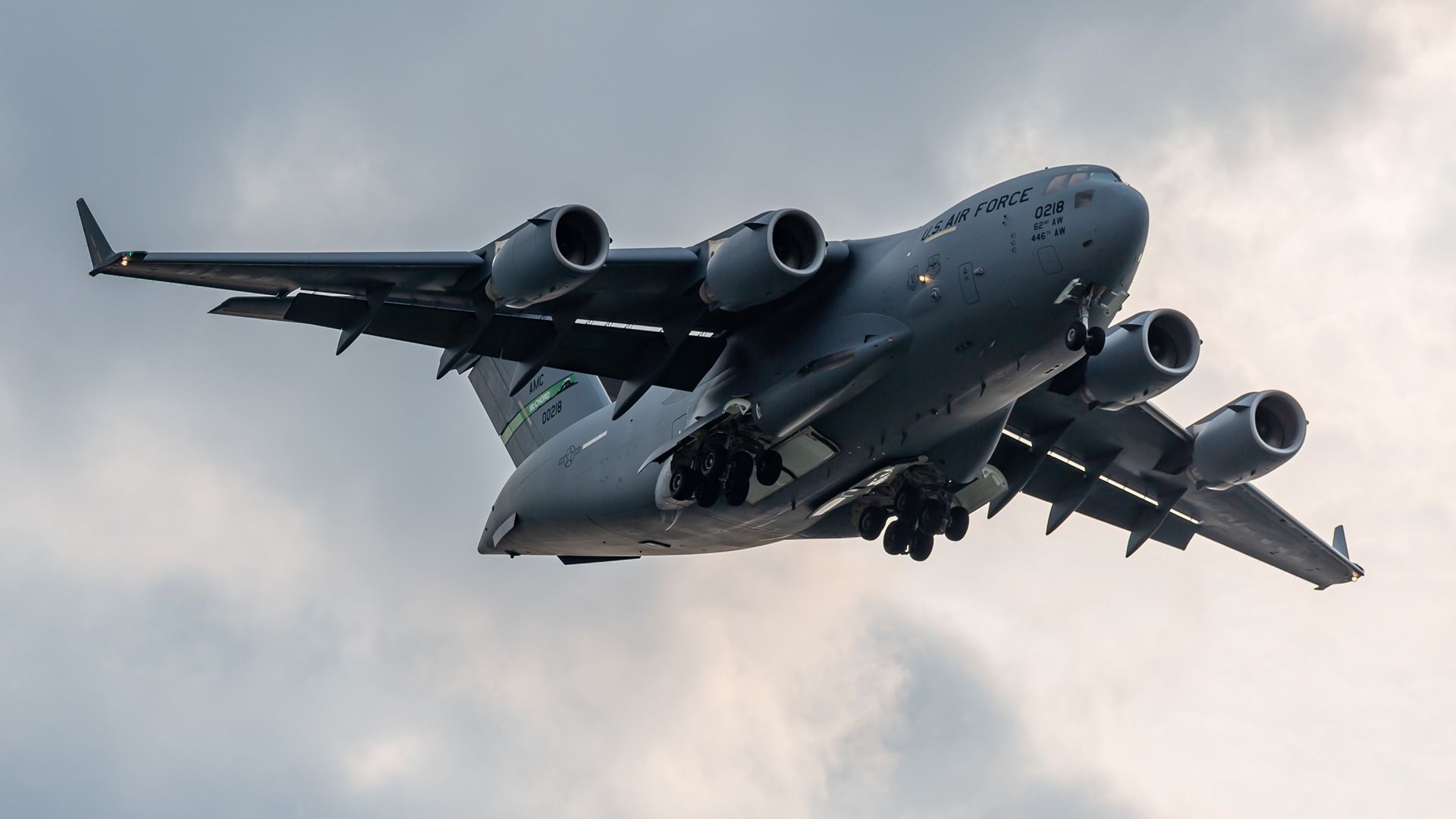Science
Exploring the Unique Asymmetry of the C-17 Globemaster III

Aviation often celebrates symmetry, but the Boeing C-17 Globemaster III features an intriguing asymmetry that has recently captured public interest. Highlighted in an article by The War Zone in September 2025, this unique design element is found in the under-fuselage sponsons that house the main landing gear. The right sponson is longer than the left, a detail that may escape casual observers but becomes apparent from certain angles. Understanding the reasons behind this asymmetry reveals insights into the aircraft’s engineering and functionality.
The right sponson contains the auxiliary power unit (APU), which provides essential systems such as electricity, hydraulics, and environmental control. Additionally, it houses a ram air turbine (RAT) that can deploy during a primary power failure, ensuring critical flight controls remain operational. This design choice results in a significant difference in length between the two sponsons, which is most noticeable under specific lighting conditions. Despite this, the C-17 is engineered to maintain stable flight, with structural reinforcements and careful weight distribution mitigating any impact on performance.
Historical Context of Asymmetrical Aircraft
Asymmetry in aviation is not a modern phenomenon. Historical examples, particularly from World War II, showcase various aircraft that experimented with unconventional layouts. The German firm Blohm & Voss was known for its innovative designs, such as the BV 141, which featured an offset engine nacelle and an observation gondola. These unconventional choices aimed to improve visibility and performance, despite the Luftwaffe ultimately favoring more traditional designs for operational purposes.
Other notable Blohm & Voss projects included the P.178, which had a single jet engine mounted under one wing, creating thrust asymmetry. Although these models remained largely experimental, they provided valuable lessons in managing aerodynamic balance and structural integrity while exploring new technologies. Additional wartime aircraft, like the Heinkel He 111 and the Bristol Blenheim, incorporated offset features to enhance visibility or accommodate equipment, proving that asymmetry could be both practical and effective in combat scenarios.
Modern Asymmetric Innovations
Post-war developments saw designers like Burt Rutan push the boundaries of asymmetric aircraft. The Rutan Model 202, known as the “Boomerang,” first flew in 1996 and featured offset engines and differing wing geometries to improve safety during engine failures. Although it remains a prototype, it exemplifies how modern materials and engineering principles can facilitate unique designs.
NASA’s AD-1, another Rutan creation, investigated the aerodynamics of an oblique wing configuration, providing insights into lift and drag distributions. Other experimental models, such as the ARES aircraft, designed for military applications, showcased asymmetric layouts that optimized combat safety by countering recoil forces.
Some military aircraft have successfully incorporated asymmetry into their designs. The A-10 Thunderbolt II features an off-center cannon and nose landing gear to balance recoil, while the de Havilland Sea Vixen utilized an offset cockpit to enhance visibility for the pilot. These models demonstrate that asymmetrical features can be effectively integrated into operational aircraft, provided they are well-engineered.
Civil aviation, typically associated with symmetry, has also seen instances of subtle asymmetry. The Hawker Siddeley Trident is notable for its offset nose landing gear, a design choice influenced by the need for space to accommodate avionics and other systems. Historical discussions among former maintenance personnel indicate that this asymmetry did not significantly affect handling or safety, highlighting how functional requirements can sometimes override aesthetic symmetry.
The principles of physics dictate that successful aircraft design must achieve a balance between lift, weight, thrust, and drag. Asymmetry can disrupt this balance, necessitating careful engineering to compensate for any adverse effects. Aircraft like the C-17 Globemaster III utilize trimming surfaces, structural reinforcements, and tailored control inputs to manage these challenges effectively. Larger aircraft, in particular, can accommodate such deviations more easily due to their inertia.
Looking ahead, asymmetrical designs may find a new role in emerging technologies such as drones and unmanned aerial vehicles (UAVs), where specialized layouts can provide distinct advantages. Nevertheless, for conventional passenger and transport aircraft, symmetry is likely to remain the preferred design choice, offering regulatory compliance and operational stability.
In summary, the exploration of asymmetry in aviation reveals a rich history of innovation and adaptation. From the C-17 Globemaster III to historical and modern prototypes, these designs illustrate the complex interplay between engineering and performance, challenging the notion that symmetry is always the optimal path in aircraft design.
-

 Health2 months ago
Health2 months agoNeurologist Warns Excessive Use of Supplements Can Harm Brain
-

 Health2 months ago
Health2 months agoFiona Phillips’ Husband Shares Heartfelt Update on Her Alzheimer’s Journey
-

 Science2 weeks ago
Science2 weeks agoBrian Cox Addresses Claims of Alien Probe in 3I/ATLAS Discovery
-

 Science2 weeks ago
Science2 weeks agoNASA Investigates Unusual Comet 3I/ATLAS; New Findings Emerge
-

 Science2 weeks ago
Science2 weeks agoScientists Examine 3I/ATLAS: Alien Artifact or Cosmic Oddity?
-

 Entertainment4 months ago
Entertainment4 months agoKerry Katona Discusses Future Baby Plans and Brian McFadden’s Wedding
-

 Science1 week ago
Science1 week agoNASA Investigates Speedy Object 3I/ATLAS, Sparking Speculation
-

 World2 months ago
World2 months agoCole Palmer’s Cryptic Message to Kobbie Mainoo Following Loan Talks
-

 Entertainment3 months ago
Entertainment3 months agoEmmerdale Faces Tension as Dylan and April’s Lives Hang in the Balance
-

 Science1 week ago
Science1 week agoNASA Scientists Explore Origins of 3I/ATLAS, a Fast-Moving Visitor
-

 Entertainment4 months ago
Entertainment4 months agoLove Island Star Toni Laite’s Mother Expresses Disappointment Over Coupling Decision
-

 Entertainment2 months ago
Entertainment2 months agoMajor Cast Changes at Coronation Street: Exits and Returns in 2025









